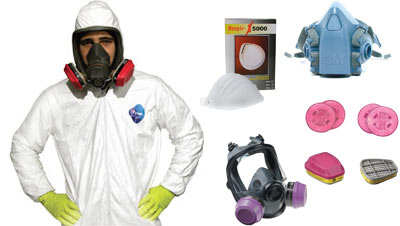Respirators, Respiratory Protection Guide
Respirators protect workers from harmful particulates, vapors and gases.
Usage of repiratory equipment must conform to OSHA regulations.

Major Classifications of Respirators
Class 1: Air Purifying Device
Class 2: Atmosphere-Supplying Respirator or Supplied Air Respirator (SAR)
Class 3: Combination Air-Purifying and Atmosphere-Supplying Device
Self-Contained Respirator Types
HEPA Only
Used when the air space has particulates like smoke, dust, mold spores, and asbestos. HEPA filters only filter out particles and have no effect on filtering gasses from chlorine bleach and other chemical sprays and gasses.
Acid Gas
Used to filter out harmful gasses such as chlorine bleach, acid-based products used in cleaning and etching as well as other corrosive gasses.
Organic
Ideal for protection when spraying disinfectants, solvents, gas vapors (non- corrosive), painting fumes, and encapsulates. Most commonly used filter for water and fire restoration.
HEPA/Organic
Provides all the protection from an organic filter with added dust protection for longer life in dust and small airborne particle environments.
Filter Classifications
With the NIOSH 42 CFR 84 Standard, nine new classes of filters (three series of filters with three levels of filter efficiency) were developed. The series are referred to as N, R, and P. The three different levels of efficiency are 95%, 99%, and 99.7% against the most difficult size particle to filter.
N-Series Filters
These filters are restricted to use in those atmospheres free of oil aerosols. They may be used for any solid or liquid airborne particulate hazard that does not contain oil. Generally these filters should be used and reused subject only to considerations of hygiene, damage, and increased breathing resistance.
N95 Particulate Filter:
At least 95% filter efficiency when tested with ~0.3 μm NaCl aerosol.
N99 Particulate Filter:
At least 99% filter efficiency when tested with ~0.3 μm NaCl aerosol.
N100 Particulate Filter:
At least 99.7% filter efficiency when tested with ~0.3 μm NaCl aerosol.
R–Series Filters
Filters intended for removal of any particle including oil-based liquid aerosol. They may be used for any solid or liquid airborne particulate hazard. If the atmosphere contains oil, the R-series filter should be used only for a single shift (or up to 8 hours continuous or intermittent use).
R95 Particulate Filter:
At lease 95% filter efficiency when tested with ~0.3 μm DOP (Dioctyl Phthalate) aerosol.
P–Series Filters
Intended for removal of any particle including oil-based liquid aerosols. They may be used for any solid or liquid particulate airborne hazard. NIOSH recommends that respirator manufacturers establish time use limitations for all P-series filters.
P-Series filters should be used and reused for no more than more 40 hours of use or 30 days, whichever occurs first, in atmospheres that contain oil aerosols unless the filter needs to be changed for hygiene reasons, is damaged, or becomes difficult to breathe through before the time limit is reached.
When used in atmospheres containing non-oil aerosol, P-series filters should be used and reused subject to conditions of hygiene, damaged, and increased breathing resistance.
P95 Particulate Filter:
At least 95% filter efficiency when tested with 0.3 μm DOP (Dioctyl Phthalate) aerosol.
P100 Particulate Filter:
At least 99.7% filter efficiency when tested with 0.3 μm DOP (Dioctyl Phthalate) aerosol.
Cleaning and Storage Procedures for Reusable Respirators
Inspection
Respirators must be inspected before each use to ensure good operating condition.
The facepiece must be repaired or replaced if there are damaged or defective parts. The following inspection procedure is suggested:
- Check facepiece for cracks, tears, and dirt. Be certain facepiece, especially face seal area, is not distorted.
- Examine inhalation valves for signs of distortion, cracking, or tearing.
- Make sure that head straps are intact and have good elasticity.
- Examine all plastic parts for signs of cracking or fatiguing. Make sure filter gaskets or seal areas are in good condition.
- Remove exhalation valve cover and examine exhalation valve and valve seat for signs of dirt, distortion, cracking, or tearing. Replace exhalation valve cover.
- Inspect lens of full facepiece for any damage that may impair respirator performance or vision.
Cleaning and storage is recommended after each use.
Alcohol wipes may be used as an interim method in the cleaning schedule for individually assigned respirators, but they must not be the only method in place. During fit testing, wipes may also be used between employees being tested. However, these respirators must be thoroughly cleaned at the end of each day, using procedures in OSHA appendix B-2 of 29 CFR 1910.134.
To Clean and Disinfect
- MediClean Germicidal Cleaner Concentrate per gallon of water to clean and disinfect nonporous personal protective safety equipment, protective headgear, hard hats, half mask respirators, full face breathing apparatus, gas masks, goggles, spectacles, face shields, hearing protectors and ear muffs. Be sure to follow all instructions per MediClean label.
- Treated surfaces must remain wet for 10 minutes.
- Caution: Cleaning at a 120-degrees F. temperature will prevent overheating and distortion of the personal safety equipment that would necessitate replacement.
- Rinse in fresh, warm water and air dry in a non-contaminated atmosphere.
- Respirator components must be inspected prior to each use. A respirator with any damaged or deteriorated components must be repaired or discarded.
- The cleaned respirator should be stored away from contaminated areas when not in use. Filter cartridges should be removed and stored in a sealed plastic bag.
NOTE: Use in conjunction with the instructions provided with the safety equipment to avoid damaging the equipment.
To Sanitize
- Add 0.5 oz. of MediClean Germicidal Cleaner Concentrate per gallon of water. Follow product label instructions.
- Treated surfaces must remain wet for 60 seconds. Allow to air dry.
- Rinse equipment with clean warm water (about 120-degrees F.) and allow to air dry prior to reuse.
NOTE: Use in conjunction with the instructions provided with the safety equipment to avoid damaging the equipment.

